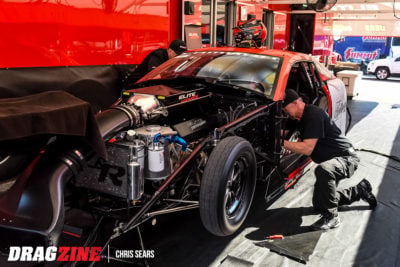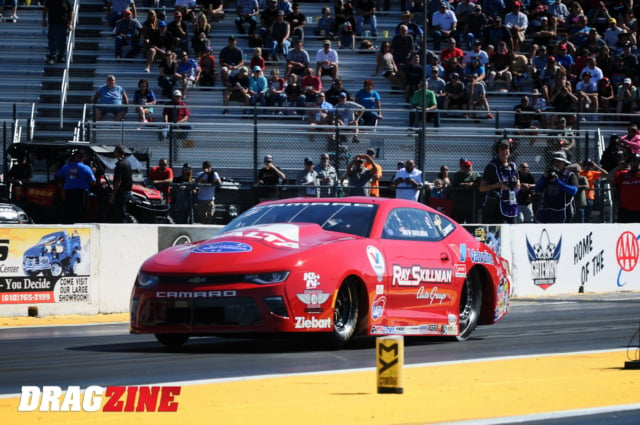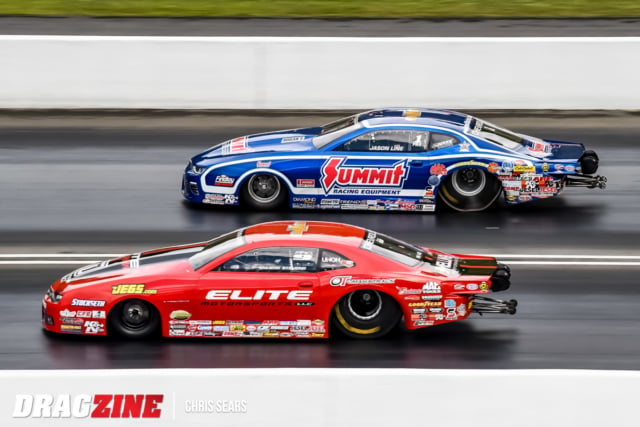On Monday, the National Hot Rod Association revealed a historic decision — one conceived by the racers and ultimately approved by the sanctioning body — to unchain engine and body manufacturers, as has been tradition since the very beginning. In doing so, any approved GM, Chrysler, or Ford engine may be used with any likewise NHRA-approved 2009 and newer body make and model from said manufacturers. The intent, of course, is to promote greater participation and competition in the beleaguered class.
The result, however, and one the racers are already alluding to, is a field comprised of GM power plants from top to bottom. And that, I believe, only sends the eliminator further down the rabbit-hole.
 Ultimately, the decision is likely only to maintain the current level of participation in the category, at best. Racers like Alan Prusiensky and Charlie Westcott, who already own Dodge and Ford-bodied cars, respectively, will be more enticed to continue, now blessed with the option of building or leasing a more competitive and readily-available GM engine. But the fans, already disenfranchised with an eliminator comprised almost entirely of Chevrolet Camaro’s, know that it’s a ruse — they aren’t dummies, after all. If anything, a Dodge Dart with a GM DRCE engine infuriates the few purists that remain even more than the lack of Dodge’s did in the first place. In other words, this only makes matter worse for the long-term health of Pro Stock. Unless, of course, fan support doesn’t matter.
Ultimately, the decision is likely only to maintain the current level of participation in the category, at best. Racers like Alan Prusiensky and Charlie Westcott, who already own Dodge and Ford-bodied cars, respectively, will be more enticed to continue, now blessed with the option of building or leasing a more competitive and readily-available GM engine. But the fans, already disenfranchised with an eliminator comprised almost entirely of Chevrolet Camaro’s, know that it’s a ruse — they aren’t dummies, after all. If anything, a Dodge Dart with a GM DRCE engine infuriates the few purists that remain even more than the lack of Dodge’s did in the first place. In other words, this only makes matter worse for the long-term health of Pro Stock. Unless, of course, fan support doesn’t matter.
At the end of the day, there’s still the same level of incentive for Chrysler and Ford to get involved in Pro Stock racing. Likewise, any of the current crop of teams running Chevrolet’s are unlikely to switch body manufacturers unless given financial support or resources to do so, and the manufacturers — Ford and Dodge — aren’t going to throw their time and money into a program to develop a body that will be mated with a GM engine.
Fans have cried foul for years about the overwhelming presence of Chevrolet Camaro’s in the class, arguing the lack of variety is the singular source of the class’ downfall — but all this ruling does is add more GM product to the class, not less. If they didn’t like Pro Stock then, they really aren’t going to like it now.
 I can’t fault the Pro Stock racers and the NHRA for their efforts. Given the present climate and trajectory of the class, they really had to do something. But this something isn’t going to save Pro Stock any more than flat hoods and fuel injection did, and may well serve to drive fans away at a greater rate than any other previous ruling has.
I can’t fault the Pro Stock racers and the NHRA for their efforts. Given the present climate and trajectory of the class, they really had to do something. But this something isn’t going to save Pro Stock any more than flat hoods and fuel injection did, and may well serve to drive fans away at a greater rate than any other previous ruling has.
Pro Stock has a future, but — as much as I hate to say it— that future doesn’t include 500 cubic-inch, naturally-aspirated engines, and only when the racers accept that a complete transformation is necessary can real progress be made toward righting the ship.
What’s your take: do you like this decision, or do you see it as a detriment to a once-great class?




